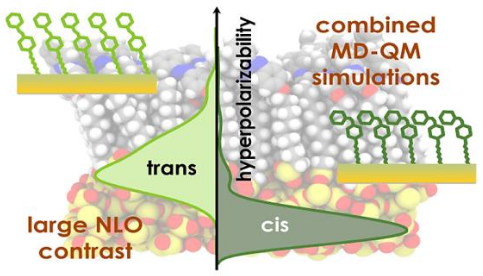Topic: Design of Molecular Materials with Photoswitchable Nonlinear Optical Responses: Interplay Between Theory and Experiments
Dr. Frederic Castet
Fecha: Jueves 05 de diciembre de 2019
Hora: 12:00 m.
Aula: Q-202 (Sección Química)
Promovido por: Grupo de Investigación GICA
Abstract
Photochromic materials that exhibit switchable second-order nonlinear optical (NLO) responses, such as second harmonic generation (SHG), are of particular interest for optical data storage or chemical sensing applications. Indeed, NLO responses being measured using low energy near-infrared wavelengths, they can be exploited to probe the electronic states of a light-responsive system without triggering uncontrolled
photoconversions. NLO switchable materials thus offer a unique way for designing molecular-scale memory devices with multiple storage and nondestructive readout capacity. [1] By constraining the alignment of the molecular units within controlled concentrations, surface coating with self-assembled monolayers (SAMs) constitutes the most effective strategy for introducing NLO chromophores into a device in view of maximizing its macroscopic second-order susceptibility. Optimizing the performances of such systems, in terms of efficiency of the switching process and amplitude of the NLO contrasts between the NLO-active and NLO-inactive states, requires multidisciplinary approaches combining molecular synthesis, surface engineering, and numerical simulations. In this talk, we will illustrate the complementarity of the experimental and
theoretical tools to design and characterize molecular NLO switches, through some representative examples taken from our recent studies. [2] In a second part, we will present a new computational approach combining molecular dynamic (MD) simulations and DFT calculations to evaluate the dynamical behavior and SHG
responses of photoresponsive SAMs. [3]
[1] F. Castet et al. Acc. Chem. Res. 2013 , 11, 2656.
[2] F. Mançois et al. Chem. Eur. J. 2009, 15, 2560 ; B. Champagne et al. J. Am. Chem. Soc. 2012, 134, 8101 ; P. Beaujean et al. J. Am. Chem. Soc. 2016, 138, 5052 ; F. Bondu et al. Chem. Eur. J. 2015, 21, 18749 ; K. Pielak J. Phys. Chem. C. 2018, 122, 26160 ; C. Tonnelé et al. Photochem. Photobio. Sci. 2019, 18, 2759.
[3] C. Tonnelé et al. PCCP 2018, 20, 21590; C. Tonnelé et al. Chem. Mat. 2019, 31, 6759.
Information about the speaker
F. Castet completed a Ph.D. in Theoretical Chemistry in 1999 at the University of Bordeaux, the subject of which was the elaboration of a correlated fragment orbital method to describe charge transfer in organic superconductors. After his PhD, he accomplished a post-doctoral stay at the University of Namur (Belgium), where he worked on the evaluation of second order optical susceptibilities of molecular assemblies and crystals. In 2000, he was recruited as Associate Professor in the chemistry department of the University Bordeaux. He obtained the accreditation to supervise researches in 2009, and was appointed Full Professor in 2014.


